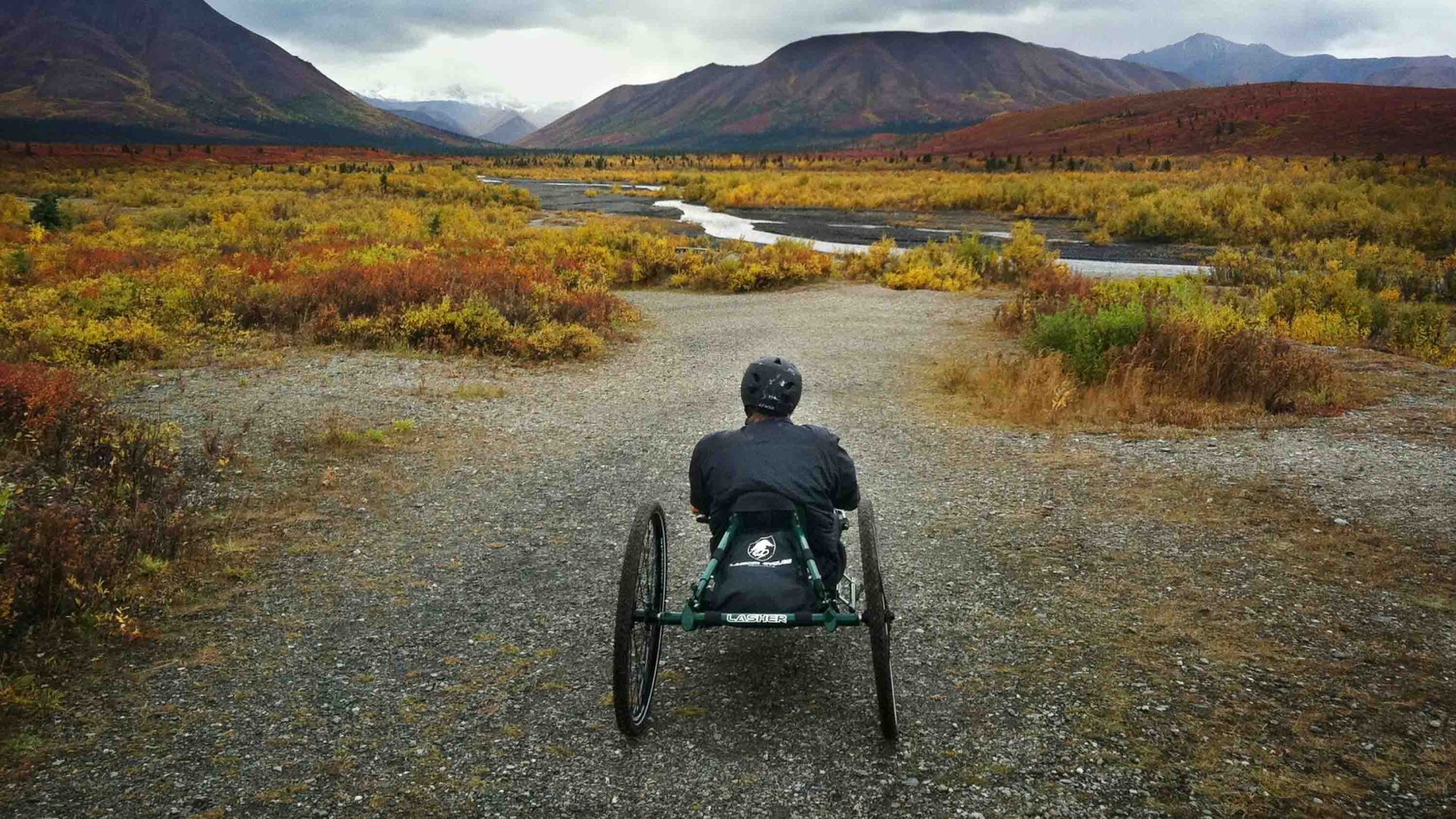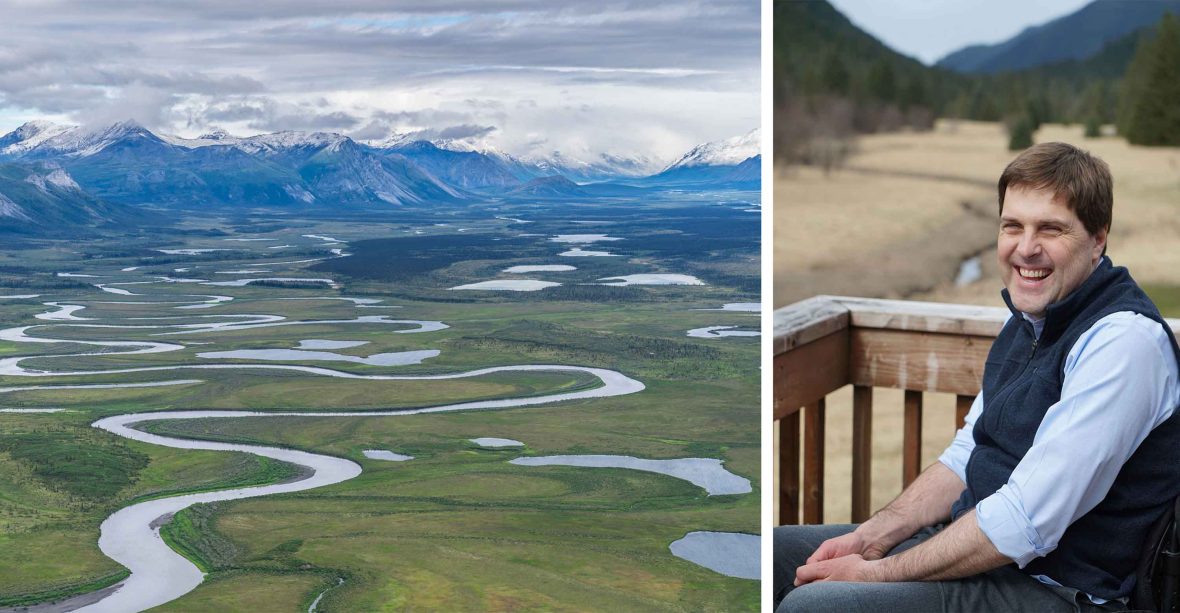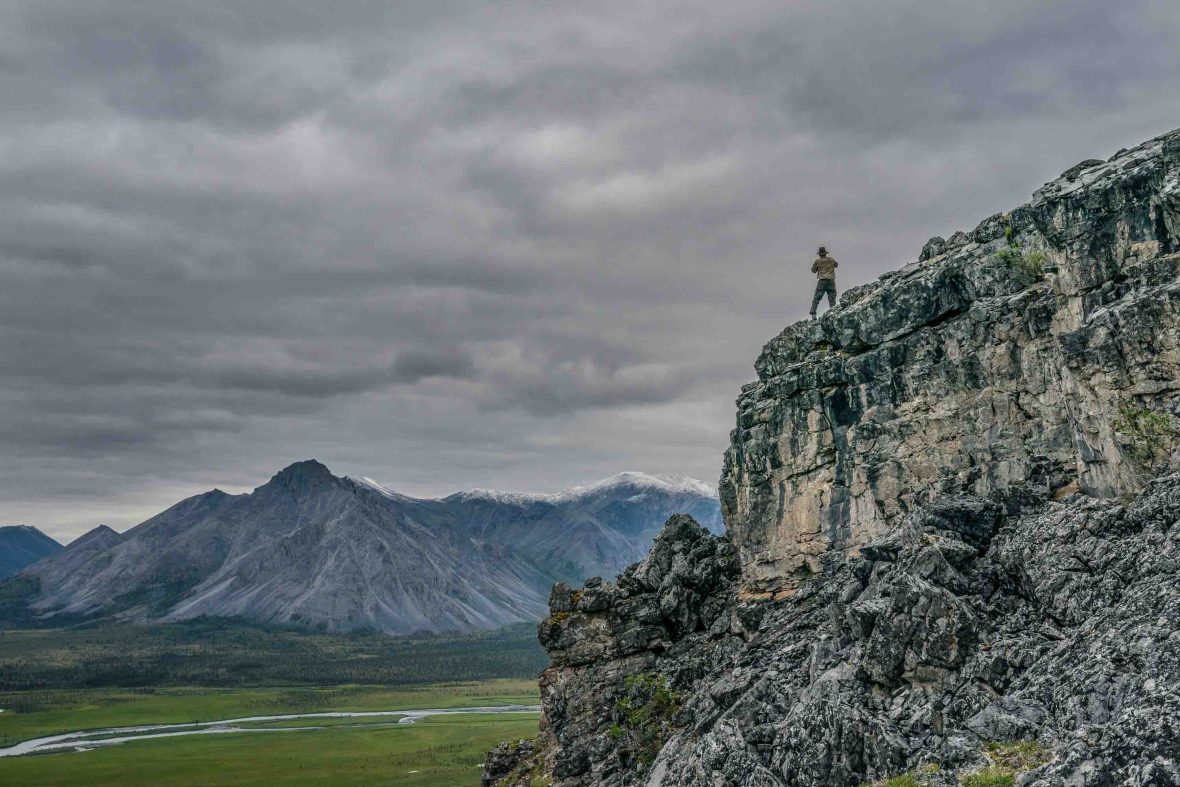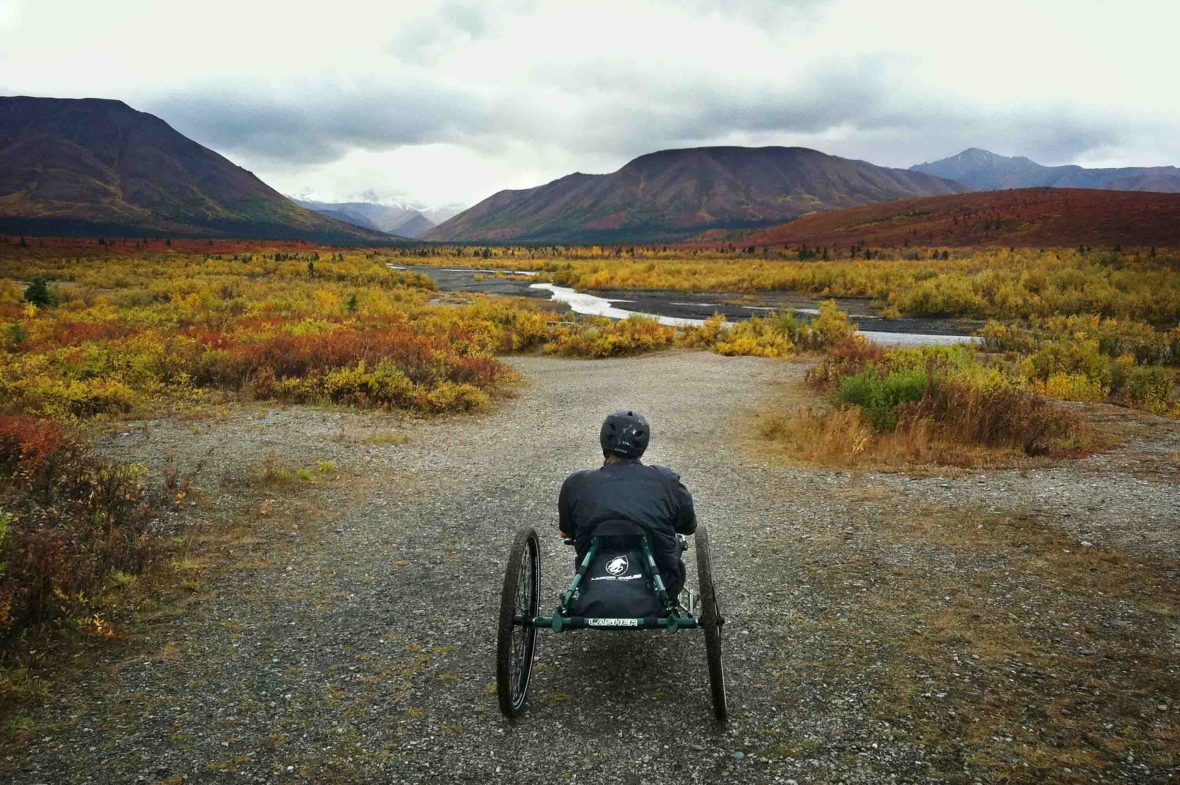
For decades, Erik Grafe has battled politicians and big oil in an effort to protect Alaska’s Arctic regions. Now he’s waging his biggest fight for one of America’s most important stretches of public land against the Trump Administration.


For decades, Erik Grafe has battled politicians and big oil in an effort to protect Alaska’s Arctic regions. Now he’s waging his biggest fight for one of America’s most important stretches of public land against the Trump Administration.
At the end of April of this year, Erik Grafe traveled from his home in Anchorage, Alaska to Washington, D.C. He was there to do the same thing he’s done for nearly 20 years: Urge lawmakers to protect the Arctic Refuge.
Located in northern Alaska, the Arctic Refuge covers an area of over 19 million acres. It’s an ecologically important area home to polar bears, migratory birds, and Indigenous communities including the Gwich’in, the Iñupiat and the Yupik people. In the late 2000s, Grafe, a lawyer for Earthjustice, an environmental law nonprofit dedicated to protecting public health, wildlife, and the environment, led the fight to block Shell’s offshore drilling operations in the Arctic Ocean, which posed severe risks to the region’s fragile ecosystem and the livelihoods of local communities, including the Gwich’in, who rely on the Arctic for its fishing and hunting resources.
In D.C., members from the Gwich’in Steering Committee (GSC), an advocacy organization representing the Gwich’in people, had joined Grafe to advocate for protection in the Arctic. On May 1 this year, just before returning to Alaska, Grafe attended an event at the Capitol building where GSC members performed traditional fiddle dancing. “It was just a few people on stage, but they brought so much happiness to the room,” says Grafe. “In sharing their traditions in music and dance, they also conveyed their tenacity and how they always center on respect, engagement, and even celebration in their advocacy.”
Grafe left the ceremony feeling uplifted. But shortly after boarding his flight, he received news: The House Environment Committee had released a draft budget reconciliation bill that sought to fast-track drilling and leasing in the Arctic Refuge and Western Arctic. The bill also aimed to exempt the projects from key environmental laws and prevent the courts from hearing challenges to permits.

Grafe and his colleagues immediately began analyzing the bill and mobilizing supporters to prevent its passage. “It was the worst bill in environmental history,” says Laura Esquivel, a senior legislative representative for Earthjustice. “It aimed to sell off our public lands to the oil and gas industry and lower how much they had to pay for them.”
In the weeks that followed, Grafe and his team worked around the clock with lawmakers to remove many of the bill’s most harmful provisions, including one that would have allowed oil and gas developers to pay for their National Environmental Policy Act (NEPA) review to be accelerated, and to not be subject to legal challenge by anybody except for them (if they didn’t like the outcome). “There were horrible provisions about limiting judicial review of decisions in the Arctic,” says Grafe. “We were able to get the worst of them taken out of the bill.”
For most environmentalists, the biggest victory came on June 28, when a section in the bill calling for the selloff of 500,000 acres of public land was removed. But Grafe still had plenty to worry about. Among other things, the bill still included a clause that allowed for more lease sales to oil and gas companies in the Arctic Refuge.
Perhaps the craziest thing about the battle to drill in the Arctic Refuge is this: Nobody really knows if there’s any oil beneath the surface.
- Erik Grafe
During the first Trump presidency, the administration approved seven drilling permits in the Arctic Refuge for the Alaska Industrial Development and Export Authority (AIDEA), an agency tasked with promoting, developing, and advancing economic growth and diversification in Alaska. The leases were voided during the Biden administration, but in March a federal court ruled that the leases must be returned to AIDEA. “Any leases or any seismic surveying activity or drilling that happens there would have huge consequences for that area,” says Grafe.
That Monday, on June 30, he arrived at his office in Anchorage. Dressed in a blue button-down shirt and a fleece vest, he poured himself a cup of coffee and stared out the window at the snowcapped Chugach Mountains. Outside, the sun shone brightly. He thought to himself: The world is falling apart, but we’ve been having a pretty nice summer here in Alaska.
Then another, darker thought crossed his mind: If outside interests do manage to secure permits to drill for oil in the Arctic Refuge, it could make it easier for them to secure drilling permits on public land throughout the rest of the country. “These are some of the most iconic, some of the last intact ecosystems,” he told me over the phone. “And if they are gonna be relegated to oil development, then what isn’t?”
Perhaps the craziest thing about the battle to drill in the Arctic Refuge is this: Nobody really knows if there’s any oil beneath the surface. While there’s been some seismic surveying and limited drilling in certain areas, no one truly knows what lies beneath. Despite this uncertainty, political and commercial forces continue to push for drilling, aiming to exploit the region’s presumed wealth.
In the 1980s, rising oil prices and the discovery of new oil reserves elsewhere in Alaska, caused oil companies to begin eyeing the Arctic Refuge’s potential reserves. President Ronald Reagan’s administration pushed for drilling, arguing that opening the Arctic Refuge to oil exploration would help reduce US dependence on foreign oil and strengthen national security. For years, environmental groups and native communities staved off most exploration.
The stakes were raised significantly in 2017, when the Tax Cuts and Jobs Act opened parts of the Arctic Refuge to oil leasing. Since then, pressure has only increased, with environmentalists, Indigenous groups, and the scientific community mounting increasingly difficult fights.

Grafe’s journey toward battling for the Arctic began after he moved to Alaska in 2006, quickly falling in love with its landscapes. Initially focused on corporate law, Grafe, who received his law degree from University of Virginia, transitioned into environmental advocacy, joining Earthjustice in 2007.
But his commitment to protecting the Arctic became even more personal after a surfing accident in Hawaii left him paralyzed. “It really brought home to me that we’re all in this together,” says Grafe. “We each have different roles and there are different ways to appreciate and feel connected to our world. Part of the job is to just kind-of help each other appreciate our world and ensure its vibrancy.”
“We shouldn’t be expanding oil production anywhere. This is a time when we should be moving away from fossil fuels.”
- Erik Grafe
Should oil companies be granted access to the Arctic Refuge, the ramifications are huge. Seismic surveys to detect oil beneath the surface are themselves destructive. To perform them, heavy trucks are driven across the tundra, disrupting caribou herds and potentially crushing polar bear dens or scaring away mothers and cubs.
Groups like the Gwich’in, who use the caribou for food, clothing, shelter, tools, would be most affected. They view the land as sacred and the caribou as essential to their culture. “Seismic testing was done in 1988,” says Kristen Moreland, executive director of Gwich’in Steering Committee. “The caribou that once went to that area to have their young ones still don’t go back to the place where they did the testing.”
The Arctic is also warming at four times the global rate, with visible impacts such as eroding coastlines and melting permafrost. Wildlife like polar bears are particularly affected, increasingly forced to den on land rather than sea ice, where they typically hunt (we’ve all seen the photos of the starving polar bears). In the face of these changes, drilling for oil would only make things worse. Infrastructure for oil extraction, including roads and pipelines, would further fragment habitats for wildlife.
Sierra Minder, a lawyer with the Alaska Oil and Gas Association, a trade group based in Anchorage argues that oil extraction in the Arctic Refuge is crucial to meet America’s energy demands. “It comes up over and over again because of its significant untapped potential,” she says. “We think extraction can be done safely, managing the local communities’ interests, as well as the preservation of the refuge itself.”
Some communities in the Western Arctic are also in favor of drilling. The Iñupiat rely on oil revenue for essential services like healthcare, education, and infrastructure, and many fear the loss of these funds as oil production declines. Grafe stresses the importance of a “just transition” for these communities, ensuring that they are not left behind as the world shifts away from fossil fuels.
“We shouldn’t be expanding oil production anywhere,” says Grafe. “This is a time when we should be moving away from fossil fuels.” The oil discovered in the Arctic wouldn’t even hit the market for at least a decade, which means it could be contributing to the problem long after its relevance. “It also costs a ton of money, so there’s something called a lock-in effect,” says Grafe. “That means that once you’ve approved it and start getting the oil out, there’s every incentive to keep pumping all the oil out until for decades into the future when we can even less afford to be burning the oil.”
For years, Grafe and his team have been able to keep drilling out of the Arctic Refuge by using existing environmental laws like the National Environmental Policy Act (NEPA) and the Endangered Species Act (ESA) as shields. NEPA, a 50-year-old law requiring careful environmental review and public input for projects, acted as a filibuster of sorts, while the ESA prevented anything that might harm endangered species, such as polar bears.
But, in July 2020, the White House Council on Environmental Quality finalized a sweeping rule to “eviscerate core components” of NEPA. The overhaul slashed requirements to study a project’s indirect and cumulative effects, effectively ignoring its climate footprint. Public comment periods were tightened and bureaucrats gained leeway to exempt pipelines, drilling leases and other projects from thorough review. This NEPA rollback, coming after years of industry griping about “unclear” environmental laws slowing development, handed oil companies the fast-track they’d long wanted.
“They’ll do whatever they can to try to shortcut them. And we’ll sue them.”
- Erik Grafe
In 2019, then-Interior Secretary (and former oil lobbyist) David Bernhardt pushed through sweeping rollbacks to ESA rules. No longer would regulators automatically protect newly listed threatened species from harm, and they could even disregard climate change impacts on habitat.
Suddenly the battle wasn’t just over leases or permits, it was over the legal foundations themselves. Instead of only suing to block a particular oil lease or road through tundra, he and his team now had to pivot to defending NEPA and the ESA, the very laws that had empowered them to challenge Arctic drilling. Soon, Earthjustice and a coalition of community and conservation groups filed suit to halt the NEPA rollbacks. But in May 2025, the Supreme Court issued a decision in Seven County Infrastructure Coalition v. Eagle County that limited the scope of environmental effects agencies must consider under NEPA.

In April 2025, the Fish and Wildlife Service and the National Marine Fisheries Service sought to rescind the definition of “harm” to exclude habitat modification, a move that could significantly weaken the ESA’s ability to protect species from habitat loss. Trump’s ‘Big Beautiful Bill’ made life for oil developers even easier, further weakening both NEPA and the ESA.
“But they’re still there and we have to defend them from further attacks by Congress and further short-cutting by the administration,” says Grafe. “They’ll do whatever they can to try to shortcut them. And we’ll sue them.”
Back in Grafe’s Anchorage office, a tailored suit hangs from a hook on his door. “It’s only there in case I need to go to court on short notice,” he says. Grafe expects that, in the coming months and years, the suit will get a lot more use.
***
Adventure.com’s reporting on US National Parks and public lands is made possible by the financial support of Intrepid Travel, as part of its United by Nature campaign. The support from Intrepid enables Adventure.com to invest in high-quality journalism and storytelling at a critical time for our wild places. Intrepid is not involved in any decisions made by Adventure.com’s editorial team. If you have leads, ideas, tips for our US National Parks and Public Lands bureau, please send a confidential email to hello@adventure.com









Can't find what you're looking for? Try using these tags: